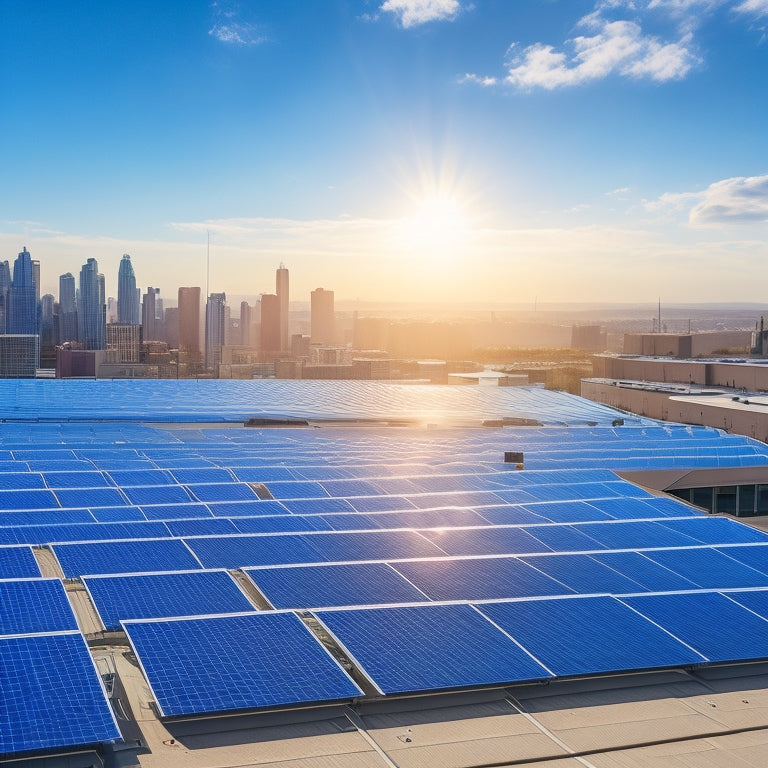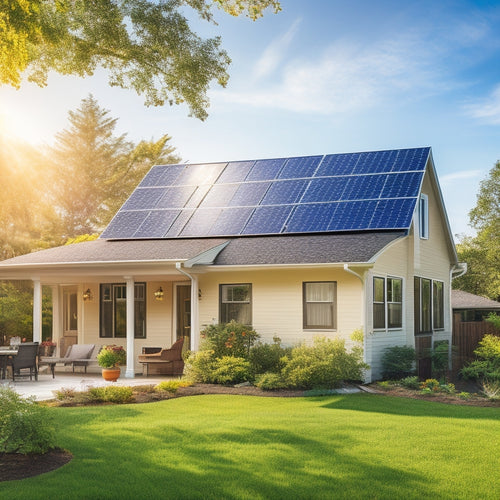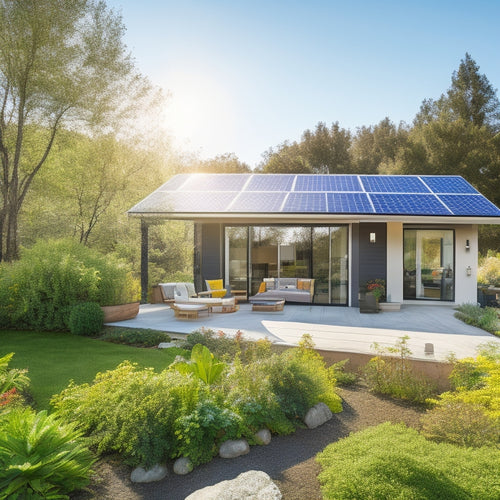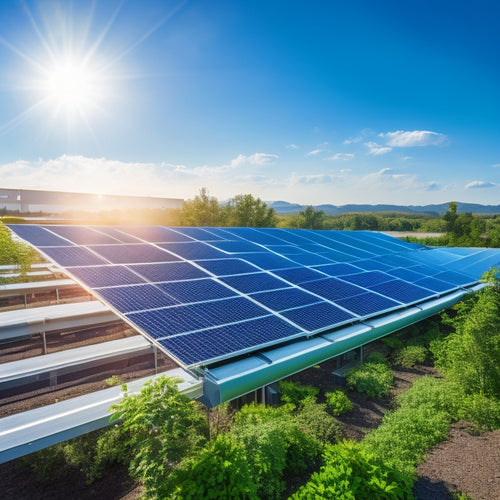
Top Solar Panels for Commercial Properties Online
Share
You're looking for top-tier solar panels for your commercial property. SunPower, LG, and First Solar are industry leaders, offering over 22% efficiency. Monocrystalline panels, known for their 15-20% efficiency rates, are ideal but pricier than polycrystalline options. Commercial panels like SunPower cost $3.30-$4.00 per watt with a 25-year warranty. First Solar panels are more affordable at $1.50-$2.00 per watt. Installation typically spans 1-2 weeks with robust warranties covering up to 25 years. Leveraging tax credits and bulk discounts can enhance cost savings. Learn which panels best match your commercial needs.
Key Takeaways
- SunPower offers high-efficiency panels with over 22% sunlight conversion and a 25-year warranty, ideal for commercial properties.
- LG panels provide a balance of efficiency, cost-effectiveness, and modularity, with installation typically completed within a week.
- First Solar panels are cost-effective at $1.50-$2.00 per watt, with a 10-year product warranty suitable for budget-conscious commercial projects.
- Monocrystalline panels offer higher efficiency (15-20%) compared to polycrystalline, making them suitable for properties with substantial energy needs.
- Tax incentives, financing options, and bulk purchase discounts significantly enhance the cost-effectiveness of commercial solar panel installations.
High-Efficiency Solar Panels
With advancements in photovoltaic technology, high-efficiency solar panels now convert over 22% of sunlight into usable electricity, making them a viable option for commercial properties. These panels maximize energy output, which is essential for meeting the substantial energy demands of such establishments.
You'll find that these high-efficiency models are designed to work seamlessly with modern energy storage systems. This guarantees you can store excess energy generated during peak sunlight hours for use during periods of low sunlight or high demand.
In addition to energy storage, another vital factor to take into account is inverter compatibility. High-efficiency solar panels often require advanced inverters capable of managing the increased energy output efficiently. Inverters convert the direct current (DC) produced by the solar panels into alternating current (AC), which is used by most commercial electrical systems.
Making sure your inverters are compatible with high-efficiency solar panels will optimize your system's performance and prevent energy losses.
Cost-Effective Solar Solutions
You can achieve significant cost savings with affordable installation options for solar panels on commercial properties. Data shows that long-term savings benefits can offset initial costs within 5 to 7 years, depending on your energy consumption.
Analyzing these financial metrics will help you make an informed decision.
Affordable Installation Options
How can businesses maximize their investment in solar energy through affordable installation options? By leveraging tax incentives and exploring various financing options, you can greatly reduce upfront costs. Many jurisdictions offer tax credits and rebates which can offset a substantial portion of your installation expenses. Additionally, various financing options like solar loans and leases provide flexible payment plans, making it easier for businesses to adopt solar technology without the heavy initial investment.
| Installation Option | Description |
|---|---|
| Tax Incentives | Federal and state tax credits reduce costs. |
| Solar Loans | Borrow funds to cover installation expenses. |
| Solar Leases | Pay monthly fees instead of upfront costs. |
| Power Purchase Agreements (PPA) | Pay only for energy produced. |
Tax incentives often include federal investment tax credits (ITC), which can cover up to 26% of installation costs. State-specific incentives further enhance savings. Solar loans enable you to own the system while spreading the cost over time. Leases and PPAs allow you to avoid initial costs, with the latter focusing on paying for the energy produced rather than the system itself.
Long-Term Savings Benefits
Investing in solar panels for commercial properties can yield substantial long-term savings by greatly reducing energy costs and providing predictable energy pricing. You'll find that solar energy systems can markedly cut your electricity bills. For instance, a 100kW system can save you up to $14,000 annually, depending on your location and energy consumption patterns.
Moreover, leveraging energy incentives and tax credits can further enhance your savings. The Federal Investment Tax Credit (ITC) allows you to deduct 26% of the installation costs from your federal taxes. Some states offer additional incentives, potentially reducing the payback period to as little as 3-5 years.
Predictable energy pricing provides another advantage. Unlike traditional energy sources, solar energy costs remain stable over time. This stability allows for more accurate long-term financial planning, reducing the risks associated with fluctuating energy prices.
Operational savings aren't the only benefit; solar panels can also increase your property's value. Studies show that commercial properties with solar energy systems sell faster and at higher prices. By investing now, you not only cut costs but also enhance your property's marketability.
Solar panels represent a cost-effective, sustainable energy solution for commercial properties.
Durable Commercial Panels
Commercial solar panels, engineered for durability, often come with warranties extending over 25 years, ensuring long-term performance and reliability. These panels are built to withstand various environmental factors, showcasing significant weather resistance. By investing in high-quality commercial solar panels, you'll be safeguarding your installation against harsh conditions like heavy rain, snow, hail, and high winds.
Data indicates that the average panel lifespan ranges between 25 to 30 years, with many manufacturers guaranteeing a minimum of 80% energy output even after 25 years of use. The robust construction of commercial panels includes tempered glass, corrosion-resistant aluminum frames, and advanced encapsulation materials, all contributing to extended durability. Recent advancements in photovoltaic technology have led to the development of more resilient solar cells, further enhancing the lifespan and efficiency of these panels.
Objective performance metrics show that durable commercial panels not only endure adverse weather conditions but also resist potential degradation from UV exposure and fluctuating temperatures. This makes them a reliable investment for any commercial property aiming to achieve sustainable energy goals.
Leading Solar Brands
When evaluating leading solar brands for commercial properties, there are several key factors to consider. Firstly, you should assess their efficiency and performance ratings, as these can significantly impact the amount of energy savings you can achieve. It's important to understand how well the solar panels will perform in your specific location and conditions.
Another crucial aspect to evaluate is the installation and maintenance requirements of the solar panels. You need to ensure that these requirements align with your operational capabilities and that you have the resources to properly install and maintain the system over its lifespan.
In addition to performance and maintenance, cost and warranty details are also essential considerations. Comparing the upfront cost of the solar panels, along with any available financing options, can help you determine the overall value of the investment. Similarly, reviewing the warranty terms and conditions can give you insight into the reliability and longevity of the solar panels.
Efficiency and Performance Ratings
When evaluating solar panels for commercial properties, it's vital to consider the efficiency and performance ratings of leading brands like SunPower, LG, and First Solar. These ratings directly impact energy production, energy storage capabilities, and panel longevity. High efficiency means more electricity generation per square meter, which is important for maximizing return on investment.
Here's a comparison of the top brands:
| Brand | Efficiency (%) | Performance Degradation (%/year) |
|---|---|---|
| SunPower | 22.8 | 0.20 |
| LG | 21.7 | 0.30 |
| First Solar | 18.6 | 0.50 |
SunPower leads with the highest efficiency at 22.8%, coupled with a low degradation rate of 0.20% per year, ensuring excellent long-term energy storage and panel longevity. LG follows with a strong 21.7% efficiency and a moderate degradation rate of 0.30%. First Solar, while having a lower efficiency of 18.6%, still offers a reliable option with a degradation rate of 0.50%.
Installation and Maintenance Requirements
After evaluating the efficiency and performance ratings, it's equally important to take into account the installation and maintenance requirements of leading solar brands like SunPower, LG, and First Solar.
When considering the installation timeline, SunPower panels generally require 1-2 weeks for a full commercial setup due to their advanced technology and integration needs. LG panels, known for their modularity, can be installed within a week. First Solar, utilizing thin-film technology, often completes installations in a similar timeframe as LG, but may vary based on project scope.
Maintenance frequency is another critical factor. SunPower panels typically need minimal maintenance, with inspections recommended annually to maintain peak performance. LG panels, with robust build quality, also require annual maintenance, primarily focused on cleaning and electrical checks. First Solar panels, given their thin-film nature, might need biannual inspections to check for potential degradation or soiling.
Understanding these requirements can have a significant impact on your long-term planning and operational efficiency. The choice of brand affects not only the initial installation timeline but also the ongoing maintenance frequency, ensuring your commercial property remains energy-efficient and cost-effective over time.
Cost and Warranty Details
Comparing the cost and warranty details of leading solar brands like SunPower, LG, and First Solar provides essential insights for making an informed investment in commercial solar solutions.
SunPower panels generally cost between $3.30 and $4.00 per watt, offering a 25-year detailed warranty that covers both product and performance.
LG panels range from $2.85 to $3.50 per watt and come with a 25-year warranty, focusing on product and linear performance degradation.
First Solar, primarily known for thin-film technology, averages around $1.50 to $2.00 per watt with a 10-year product warranty and a 25-year performance warranty.
When evaluating costs, consider available financing options like solar loans, leases, and power purchase agreements (PPAs). These can significantly reduce upfront expenses and align costs with energy savings over time. Additionally, tax incentives such as the Investment Tax Credit (ITC) and local rebates can lower the overall financial burden, enhancing the return on investment.
Understanding warranty coverage is important. Long-term warranties ensure your panels maintain efficiency and performance, safeguarding your investment. Combining robust warranties with favorable financing options and tax incentives maximizes the economic and operational benefits of commercial solar installations.
Monocrystalline Vs. Polycrystalline
Monocrystalline solar panels, often more efficient and with a higher power output, typically cost more than polycrystalline options, which are known for their lower price point and slightly reduced efficiency. When selecting between these two, consider their aesthetic appeal; monocrystalline panels have a uniform, sleek black appearance, making them more visually appealing for commercial properties. Polycrystalline panels, on the other hand, have a blue, speckled look that some might find less attractive.
Monocrystalline panels excel in temperature resistance, maintaining higher efficiency in hot conditions. They generally have an efficiency rate of 15-20%, compared to the 13-16% range of polycrystalline panels. This makes monocrystalline a better choice for areas with higher temperatures, ensuring steady energy production.
In terms of longevity, both panel types offer robust performance, typically lasting 25 years or more. However, the higher initial investment in monocrystalline panels can be offset by their superior performance and lower degradation rate over time.
Conversely, if budget constraints are a priority, polycrystalline panels provide a cost-effective solution without compromising too much on efficiency. Analyzing these factors will help you choose the most suitable option for your commercial property.
Installation Services Online
Finding reliable installation services online is vital for guaranteeing the peak performance and longevity of your commercial solar panel system. With the advancement of technology, many companies now offer online consultations and remote monitoring, making the installation process more streamlined and efficient.
When selecting an installation service, it's important to evaluate their offerings thoroughly:
| Service Feature | Description |
|---|---|
| Online Consultations | Provides virtual assessments and planning |
| Remote Monitoring | Enables real-time performance tracking |
| Installation Speed | Time taken to complete the installation |
| Customer Support | Availability and responsiveness of support |
Online consultations allow you to receive expert advice without the need for an on-site visit, saving time and logistics costs. These virtual assessments ensure that your system is tailored to your specific property needs. Remote monitoring, on the other hand, offers continuous oversight of your solar panels, helping to quickly identify and address any issues that may arise, enhancing system reliability and efficiency.
Energy Output Comparison
To determine the most efficient solar panel option for your commercial property, analyze the energy output metrics of various panel types, including polycrystalline, thin-film, and bifacial modules. Each type offers distinct advantages regarding power density and overall efficiency.
Polycrystalline panels typically have a power density range of 15-17%, making them a reliable choice for many commercial installations.
However, thin-film panels, though generally less efficient with a power density around 10-12%, may be advantageous in specific scenarios due to their lightweight and flexible nature.
Bifacial solar panels stand out with their ability to capture sunlight on both sides, boosting energy output significantly. Their power density can reach up to 22%, making them a top contender in maximizing energy harvest.
Conduct a comparative analysis based on your property's specific needs and constraints, such as available roof space, shading issues, and budget considerations.
Bulk Purchase Discounts
Taking advantage of bulk purchase discounts can greatly reduce the overall cost of installing solar panels on commercial properties. When you buy in large quantities, suppliers often offer group pricing, which can lead to significant savings. For instance, purchasing solar panels in bulk can lower the per-unit cost by up to 20%, depending on the supplier and the number of units ordered.
Wholesale options are another effective way to cut costs. Many suppliers provide wholesale pricing tiers that become more advantageous as the volume of the order increases. This means that the more panels you purchase, the lower the cost per panel. Additionally, some suppliers offer tiered discounts that can reduce costs by an additional 5-10% for particularly large orders.
Bulk purchase discounts and wholesale options not only lower initial investment costs but also improve the return on investment (ROI) for your solar panel project. By reducing the upfront capital expenditure, you can achieve faster payback periods and higher long-term savings.
Frequently Asked Questions
How Do Solar Panels Impact Property Resale Value?
Solar panels can boost property resale value by up to 4.1%, according to Berkeley Lab. You'll benefit from energy savings and attract eco-conscious buyers by highlighting the environmental benefits. It's a smart, sustainable investment.
Are There Government Incentives for Commercial Solar Installations?
Think of government incentives as the fuel powering your solar journey. Yes, you can get tax credits and utility rebates for commercial solar installations. These incentives reduce your upfront costs and improve your return on investment.
What Maintenance Do Commercial Solar Panels Require?
You need to schedule cleaning frequency based on local conditions, typically twice a year, to guarantee peak efficiency. Performance monitoring should be continuous, using automated systems to detect and address issues promptly, maintaining panel productivity.
Can Solar Panels Be Installed on Older Buildings?
Did you know that 85% of older buildings can support solar panels? Before installation, you must assess structural integrity and roof compatibility to confirm safety. Proper evaluation guarantees your building can efficiently harness solar energy.
How Long Do Solar Panels Typically Last?
Solar panels typically last 25-30 years. You'll need to take into account degradation rates, which are around 0.5-1% annually. Warranty periods often cover 25 years, ensuring panels maintain a significant portion of their efficiency throughout their lifespan.
Conclusion
To sum up, you've explored high-quality solar panels for commercial properties, focusing on efficiency, cost-effectiveness, and durability. Brands like Tesla and SunPower offer advanced solutions, while monocrystalline panels outperform polycrystalline in energy output.
Online installation services streamline the process, and bulk purchase discounts sweeten the deal. So, don't dilly-dally; harness the power of the sun and make a data-driven choice for your commercial property today.
Your future self will thank you for the energy savings!
Related Posts
-

How to Finance Home Solar Panels
Financing home solar panels offers several strategies to lighten your initial costs while maximizing long-term benefi...
-

Green Home Improvements Using Solar Power
Investing in solar power alters your home into a sustainable haven while slashing energy costs. You can greatly reduc...
-

Solar Energy Efficiency Improvements for Businesses
Improving solar energy efficiency for your business can lead to considerable cost savings and enhance your sustainabi...


